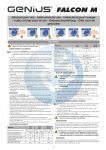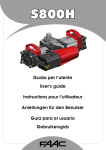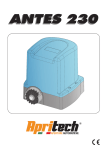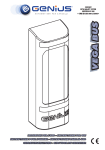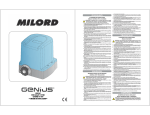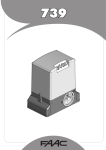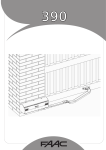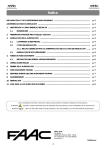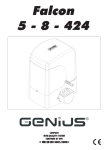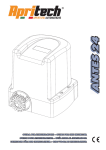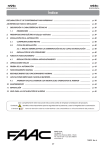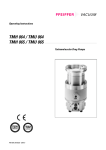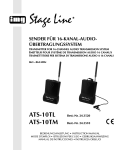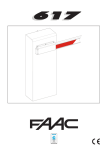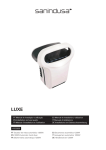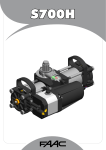Download Istruzioni per l`uso - Instructions for use
Transcript
739 Istruzioni per l’uso - Instructions for use - Instructions pour l’usager - Instrucciones para el uso - Gebrauchsanleitung - Gids voor de gebruiker ITALIANO AVVERTENZE PER L’INSTALLATORE OBBLIGHI GENERALI PER LA SICUREZZA ATTENZIONE! È importante per la sicurezza delle persone seguire attentamente tutta l’istruzione. Una errata installazione o un errato uso del prodotto può portare a gravi danni alle persone. 1. Leggere attentamente le istruzioni prima di iniziare l’installazione del prodotto. 2. I materiali dell’imballaggio (plastica, polistirolo, ecc.) non devono essere lasciati alla portata dei bambini in quanto potenziali fonti di pericolo. 3. Conservare le istruzioni per riferimenti futuri. 4. Questo prodotto è stato progettato e costruito esclusivamente per l’utilizzo indicato in questa documentazione. Qualsiasi altro utilizzo non espressamente indicato potrebbe pregiudicare l’integrità del prodotto e/o rappresentare fonte di pericolo. 5. FAAC declina qualsiasi responsabilità derivata dall’uso improprio o diverso da quello per cui l’automatismo è destinato. 6. Non installare l’apparecchio in atmosfera esplosiva: la presenza di gas o fumi infiammabili costituisce un grave pericolo per la sicurezza. 7. Gli elementi costruttivi meccanici devono essere in accordo con quanto stabilito dalle Norme EN 12604 e EN 12605. 8. Per i Paesi extra-CEE, oltre ai riferimenti normativi nazionali, per ottenere un livello di sicurezza adeguato, devono essere seguite le Norme sopra riportate. 9. FAAC non è responsabile dell’inosservanza della Buona Tecnica nella costruzione delle chiusure da motorizzare, nonché delle deformazioni che dovessero intervenire nell’utilizzo. 10. L’installazione deve essere effettuata nell’osservanza delle Norme EN 12453 e EN 12445. Il livello di sicurezza dell’automazione deve essere C+D. 11. Prima di effettuare qualsiasi intervento sull’impianto, togliere l’alimentazione elettrica e scollegare le batterie. 12. Prevedere sulla rete di alimentazione dell’automazione un interruttore onnipolare con distanza d’apertura dei contatti uguale o superiore a 3 mm. È consigliabile l’uso di un magnetotermico da 6A con interruzione onnipolare. 13. Verificare che a monte dell’impianto vi sia un interruttore differenziale con soglia da 0,03 A. 14. Verificare che l’impianto di terra sia realizzato a regola d’arte e collegarvi le parti metalliche della chiusura. 15. L’automazione dispone di una sicurezza intrinseca antischiacciamento costituita da un controllo di coppia. E’ comunque necessario verificarne la sogli di intervento secondo quanto previsto dalle Norme indicate al punto 10. 16. I dispositivi di sicurezza (norma EN 12978) permettono di proteggere eventuali aree di pericolo da Rischi meccanici di movimento, come ad Es. schiacciamento, convogliamento, cesoiamento. 17. Per ogni impianto è consigliato l’utilizzo di almeno una segnalazione luminosa nonché di un cartello di segnalazione fissato adeguatamente sulla struttura dell’infisso, oltre ai dispositivi citati al punto “16”. 18. FAAC declina ogni responsabilità ai fini della sicurezza e del buon funzionamento dell’automazione, in caso vengano utilizzati componenti dell’impianto non di produzione FAAC. 19. Per la manutenzione utilizzare esclusivamente parti originali FAAC. 20. Non eseguire alcuna modifica sui componenti facenti parte del sistema d’automazione. 21. L’installatore deve fornire tutte le informazioni relative al funzionamento manuale del sistema in caso di emergenza e consegnare all’Utente utilizzatore dell’impianto il libretto d’avvertenze allegato al prodotto. 22. Non permettere ai bambini o persone di sostare nelle vicinanze del prodotto durante il funzionamento. 23. L’applicazione non può essere utilizzata da bambini, da persone con ridotte capacità fisiche, mentali, sensoriali o da persone prive di esperienza o del necessario addestramento. 24. Tenere fuori dalla portata dei bambini radiocomandi o qualsiasi altro datore di impulso, per evitare che l’automazione possa essere azionata involontariamente. 25. Il transito tra le ante deve avvenire solo a cancello completamente aperto. 26. L’utente utilizzatore deve astenersi da qualsiasi tentativo di riparazione o d’intervento e deve rivolgersi solo ed esclusivamente a personale qualificato FAAC o centri d’assistenza FAAC. 27. Tutto quello che non è previsto espressamente in queste istruzioni non è permesso. ENGLISH IMPORTANT NOTICE FOR THE INSTALLER GENERAL SAFETY REGULATIONS ATTENTION! To ensure the safety of people, it is important that you read all the following instructions. Incorrect installation or incorrect use of the product could cause serious harm to people. 1. Carefully read the instructions before beginning to install the product. 2. Do not leave packing materials (plastic, polystyrene, etc.) within reach of children as such materials are potential sources of danger. 3. Store these instructions for future reference. 4. This product was designed and built strictly for the use indicated in this documentation. Any other use, not expressly indicated here, could compromise the good condition/ operation of the product and/or be a source of danger. 5. FAAC declines all liability caused by improper use or use other than that for which the automated system was intended. 6. Do not install the equipment in an explosive atmosphere: the presence of inflammable gas or fumes is a serious danger to safety. 7. The mechanical parts must conform to the provisions of Standards EN 12604 and EN 12605. 8. For non-EU countries, to obtain an adequate level of safety, the Standards mentioned above must be observed, in addition to national legal regulations. 9. FAAC is not responsible for failure to observe Good Technique in the construction of the closing elements to be motorised, or for any deformation that may occur during use. 10. The installation must conform to Standards EN 12453 and EN 12445. The safety level of the automated system must be C+D. 11. Before attempting any job on the system, cut out electrical power and disconnect the batteries. 12. The mains power supply of the automated system must be fitted with an all-pole switch with contact opening distance of 3mm or greater. Use of a 6A thermal breaker with all-pole circuit break is recommended. 13. Make sure that a differential switch with threshold of 0.03 A is fitted upstream of the system. 14. Make sure that the earthing system is perfectly constructed, and connect metal parts of the means of the closure to it. 15. The automated system is supplied with an intrinsic anti-crushing safety device consisting of a torque control. Nevertheless, its tripping threshold must be checked as specified in the Standards indicated at point 10. 16. The safety devices (EN 12978 standard) protect any danger areas against mechanical movement Risks, such as crushing, dragging, and shearing. 17. Use of at least one indicator-light is recommended for every system, as well as a warning sign adequately secured to the frame structure, in addition to the devices mentioned at point “16”. 18. FAAC declines all liability as concerns safety and efficient operation of the automated system, if system components not produced by FAAC are used. 19. For maintenance, strictly use original parts by FAAC. 20. Do not in any way modify the components of the automated system. 21. The installer shall supply all information concerning manual operation of the system in case of an emergency, and shall hand over to the user the warnings handbook supplied with the product. 22. Do not allow children or adults to stay near the product while it is operating. 23. The application cannot be used by children, by people with reduced physical, mental, sensorial capacity, or by people without experience or the necessary training. 24. Keep remote controls or other pulse generators away from children, to prevent the automated system from being activated involuntarily. 25. Transit through the leaves is allowed only when the gate is fully open. 26. The User must not in any way attempt to repair or to take direct action and must solely contact qualified FAAC personnel or FAAC service centres. 27. Anything not expressly specified in these instructions is not permitted. FRANÇAIS CONSIGNES POUR L’INSTALLATEUR RÈGLES DE SÉCURITÉ ATTENTION! Il est important, pour la sécurité des personnes, de suivre à la lettre toutes les instructions. Une installation erronée ou un usage erroné du produit peut entraîner de graves conséquences pour les personnes. 1. Lire attentivement les instructions avant d’installer le produit. 2. Les matériaux d’emballage (matière plastique, polystyrène, etc.) ne doivent pas être laissés à la portée des enfants car ils constituent des sources potentielles de danger. 3. Conserver les instructions pour les références futures. 4. Ce produit a été conçu et construit exclusivement pour l’usage indiqué dans cette documentation. Toute autre utilisation non expressément indiquée pourrait compromettre l’intégrité du produit et/ou représenter une source de danger. 5. FAAC décline toute responsabilité qui dériverait d’usage impropre ou différent de celui auquel l’automatisme est destiné. 6. Ne pas installer l’appareil dans une atmosphère explosive: la présence de gaz ou de fumées inflammables constitue un grave danger pour la sécurité. 7. Les composants mécaniques doivent répondre aux prescriptions des Normes EN 12604 et EN 12605. 8. Pour les Pays extra-CEE, l’obtention d’un niveau de sécurité approprié exige non seulement le respect des normes nationales, mais également le respect des Normes susmentionnées. 9. FAAC n’est pas responsable du non-respect de la Bonne Technique dans la construction des fermetures à motoriser, ni des déformations qui pourraient intervenir lors de l’utilisation. 10. L’installation doit être effectuée conformément aux Normes EN 12453 et EN 12445. Le niveau de sécurité de l’automatisme doit être C+D. 11. Couper l’alimentation électrique et déconnecter la batterie avant toute intervention sur l’installation. 12. Prévoir, sur le secteur d’alimentation de l’automatisme, un interrupteur omnipolaire avec une distance d’ouverture des contacts égale ou supérieure à 3 mm. On recommande d’utiliser un magnétothermique de 6A avec interruption omnipolaire. 13. Vérifier qu’il y ait, en amont de l’installation, un interrupteur différentiel avec un seuil de 0,03 A. 14. Vérifier que la mise à terre est réalisée selon les règles de l’art et y connecter les pièces métalliques de la fermeture. 15. L’automatisme dispose d’une sécurité intrinsèque anti-écrasement, formée d’un contrôle du couple. Il est toutefois nécessaire d’en vérifier le seuil d’intervention suivant les prescriptions des Normes indiquées au point 10. 16. Les dispositifs de sécurité (norme EN 12978) permettent de protéger des zones éventuellement dangereuses contre les Risques mécaniques du mouvement, comme l’écrasement, l’acheminement, le cisaillement. 17. On recommande que toute installation soit doté au moins d’une signalisation lumineuse, d’un panneau de signalisation fixé, de manière appropriée, sur la structure de la fermeture, ainsi que des dispositifs cités au point “16”. 18. FAAC décline toute responsabilité quant à la sécurité et au bon fonctionnement de l’automatisme si les composants utilisés dans l’installation n’appartiennent pas à la production FAAC. 19. Utiliser exclusivement, pour l’entretien, des pièces FAAC originales. 20. Ne jamais modifier les composants faisant partie du système d’automatisme. 21. L’installateur doit fournir toutes les informations relatives au fonctionnement manuel du système en cas d’urgence et remettre à l’Usager qui utilise l’installation les “Instructions pour l’Usager” fournies avec le produit. 22. Interdire aux enfants ou aux tiers de stationner près du produit durant le fonctionnement. 23. Ne pas permettre aux enfants, aux personennes ayant des capacités physiques, mentales et sensorielles limitées ou dépourvues de l’expérience ou de la formation nécessaires d’utiliser l’application en question. 24. Eloigner de la portée des enfants les radiocommandes ou tout autre générateur d’impulsions, pour éviter tout actionnement involontaire de l’automatisme. 25. Le transit entre les vantaux ne doit avoir lieu que lorsque le portail est complètement ouvert. 26. L’utilisateur doit s’abstenir de toute tentative de réparation ou d’intervention et doit s’adresser uniquement et exclusivement au personnel qualifié FAAC ou aux centres d’assistance FAAC. 27. Tout ce qui n’est pas prévu expressément dans ces instructions est interdit. ESPAÑOL ADVERTENCIAS PARA EL INSTALADOR REGLAS GENERALES PARA LA SEGURIDAD ATENCION! Es sumamente importante para la seguridad de las personas seguir atentamente las presentes instrucciones. Una instalación incorrecta o un uso impropio del producto puede causar graves daños a las personas. ITALIANO FUNZIONAMENTO MANUALE Leggere attentamente le istruzioni prima di utilizzare il prodotto e conservarle per eventuali necessità future Lo sblocco manuale è un dispositivo che permette di svincolare l’operatore dal cancello permettendone la movimentazione manuale. NORME GENERALI DI SICUREZZA L’automazione 739, se correttamente installata ed utilizzata, garantisce un elevato grado di sicurezza. Alcune semplici norme di comportamento possono evitare inoltre inconvenienti accidentali: Prima di agire sul dispositivo di sblocco togliere tensione all’impianto agendo sull’interruttore differenziale a monte del motoriduttore. IL DISPOSITIVO DI SBLOCCO NON SI DEVE CONSIDERARE UN ARRESTO D’EMERGENZA • Non sostare e non permettere a bambini, persone o cose di sostare nelle vicinanze dell’automazione, sopprattutto durante il funzionamento. • Tenere fuori dalla portata dei bambini, radiocomandi o qualsiasi altro datore d’impulso che possa azionare involontariamente l’automazione. • Non permettere ai bambini di giocare con l’automazione. • Non contrastare volontariamente il movimento del cancello. • Evitare che rami o arbusti possano interferire col movimento del cancello. • Mantenere efficienti e ben visibili i sistemi di segnalazione luminosa. • Non tentare di azionare manualmente il cancello se non dopo averlo sbloccato. • In caso di malfunzionamenti, sbloccare il cancello per consentire l’accesso ed attendere l’intervento tecnico di personale qualificato. • Una volta predisposto il funzionamento manuale, prima di ripristinare il funzionamento normale, togliere alimentazione elettrica all’impianto. • Non eseguire alcuna modifica sui componenti facenti parte il sistema d’automazione. • Astenersi da qualsiasi tentativo di riparazione o d’intervento diretto e rivolgersi solo a personale qualificato. • Far verificare almeno semestralmente l’efficienza dell’automazione, dei dispositivi di sicurezza e del collegamento di terra da personale qualificato. Nel caso sia necessario azionare manualmente il cancello a causa di mancanza di alimentazione elettrica o disservizio dell’automazione, è necessario agire sul dispositivo di sblocco come segue: 1. Inserire l’apposita chiave in dotazione nella serratura, Fig. 1 Rif. , e ruotarla in senso orario come indicato in Fig. 1 Rif. . 2. Ruotare il sistema di sblocco in senso orario di circa 180°, come indicato in Fig. 1 Rif. . 3. Effettuare manualmente la manovra di apertura o chiusura. DESCRIZIONE • L’automazione 739 è ideale per il controllo di aree di accesso veicolare in ambito residenziale. • 739 per cancelli scorrevoli è un operatore elettromeccanico che trasmette il movimento all’anta tramite un pignone a cremagliera. • Per il dettagliato comportamento del cancello scorrevole nelle diverse logiche di funzionamento, fare riferimento al Tecnico d’installazione. • Nelle automazioni sono presenti dispositivi di rilevazione ostacolo (fotocellule) che impediscono la richiusura del cancello quando un ostacolo si trova nella zona da loro protetta. • Il sistema garantisce il blocco meccanico quando il motore non è in funzione e quindi non occorre installare alcuna serratura. • L’apertura manuale è quindi possibile solo intervenendo sull’apposito sistema di sblocco. • Il motoriduttore è dotato di frizione elettronica regolabile che permette un uso sicuro dell’automazione. • L’apparecchiatura elettronica è incorporata nel motoriduttore. • Un comodo sblocco manuale rende manovrabile il cancello in caso di black-out o disservizio. • La segnalazione luminosa indica il movimento in atto del cancello. Fig. 1 RIPRISTINO DEL FUNZIONAMENTO NORMALE Per evitare che un impulso involontario possa azionare il cancello durante la manovra , prima di ribloccare l’operatore, togliere alimentazione all’impianto. 1. Ruotare il sistema di sblocco in senso antiorario di circa 180°, come indicato in Fig. 2 rif. . 2. Ruotare la chiave in senso antiorario, Fig. 2 rif. , ed estrarla dalla serratura, come indicato in Fig. 2 rif. . 3. Muovere il cancello fino all’ingranamento dello sblocco. Prima di ripristinare l’alimentazione al sistema verificare che il cancello non si possa muovere manualmente. CARATTERISTICHE TECNICHE MODELLO 739 230V 739 24V 230V~ 50Hz 230/115V~ 50/60Hz Potenza assorbita (W) 350 70 Corrente assorbita (A) 1.5 3 Condensatore (µF) 10 - Spinta sul pignone (daN) 45 40 Coppia (Nm) 18 13.5 Termoprotezione avvolgimento (°C) 140 - Peso anta max. (Kg) 500 400 Tipo di pignone Z16 Z16 Velocità del cancello (m/min) 12 12 Lunghezza massima cancello (m) 15 15 Tipo di finecorsa Meccanico Meccanico Frizione Elettronica Elettronica Alimentazione (+6% -10%) Frequenza d’utilizzo S3 - 30% 100% Temperatura d’utlizzo (°C) -20 ÷ +55 -20 ÷ +55 Peso motoriduttore (Kg) Grado di protezione Ingombro motoriduttore 10 8.5 IP44 IP44 Vedi Fig. 2 Vedi Fig. 2 Fig. 2 MANUTENZIONE Al fine d’assicurare nel tempo un corretto funzionamento ed un costante livello di sicurezza è opportuno eseguire, con cadenza semestrale, un controllo generale dell’impianto. Nel fascicolo “Istruzioni per l’uso” è stato predisposto un modulo per la registrazione degli interventi di manutenzione. RIPARAZIONI L’utente utilizzatore deve astenersi da qualsiasi tentativo di riparazione o d’intervento e deve rivolgersi solo ed esclusivamente a personale qualificato FAAC o centri d’assistenza FAAC. 2 ENGLISH MANUAL OPERATION Read the instructions carefully before using the product and store them for future use The manual release is a device that makes it possible to disconnect the operator from the gate, thus enabling manual movement. GENERAL SAFETY REGULATIONS Before using the release device, cut power to the system, with the differential switch upstream of the gearmotor. If correctly installed and used, the 739 automated system will ensure a high degree of safety. Some simple rules on behaviour can prevent accidental trouble: THE RELEASE DEVICE MUST NOT BE CONSIDERED AN EMERGENCY STOP • Do not stand near the automatic system, and do not allow children, persons or things to do so, especially when it is operating. • Keep radio-controls, or any other pulse generators that could involuntarily activate the automated system, well away from children. • Do not allow children to play with the automated system. • Do not willingly obstruct gate movement. • Prevent any branches or shrubs from interfering with gate movement. • Keep the indicator-lights efficient and easy to see. • Do not attempt to activate the gate by hand unless you have released it. • In the event of malfunctions, release the gate to allow access and wait for qualified technical personnel to do the necessary work. • When you have set manual operation mode, cut power to the system before restoring normal operation. • Do not in any way modify the components of the automated system. • Do not attempt any kind of repair or direct action whatever and contact qualified personnel only. • At least every six months: arrange a check by qualified personnel of the automatic system, safety devices and earth connection. If the gate has to be moved manually due to a power cut or fault of the automated system, use the release device as follows: 1. Fit the supplied key in the lock, Fig. 1 Ref. , and turn it clockwise as shown in Fig. 1 Ref. . 2. Turn the release system clockwise by about 180°, as shown in Fig. 1 Ref. . 3. Open and close the gate manually. DESCRIPTION • The 739 automated system is ideal for controlling vehicle access areas in residential environments. • 739 for sliding gates is an electro-mechanical operator which transmits motion to the leaf via a rack and pinion. • For details on sliding gate behaviour in different function logics, consult the installation Technician. • Automated systems include obstacle detection devices (photocells) that prevent the gate from closing when there is an obstacle in the area they protect. • The system ensures mechanical locking when the motor is not operating and, therefore, installing a lock is unnecessary. • Manual opening is, therefore, only possible by using the release system. • The gearmotor has an adjustable electronic clutch enabling safe use of the automated system. • The control unit is built into the gearmotor. • A handy manual release facility makes it possible to move the gate in the event of a power cut or fault. • The warning-light indicates that the gate is currently moving. Fig. 1 RESTORING NORMAL OPERATION MODE To prevent an involuntary pulse from activating the gate during the manoeuvre, cut power to the system before re-locking the operator. 1. Turn the release system anti-clockwise by about 180°, as shown in Fig. 2 ref. . 2. Turn the key anti-clockwise, Fig. 2 ref. , and remove it from the lock, as shown in Fig. 2 ref. . 3. Move the gate until it meshes to release. TECHNICAL SPECIFICATIONS MODEL 739 230V 739 24V 230V~ 50Hz 230/115V~ 50/60Hz Absorbed power (W) 350 70 Absorbed current (A) 1.5 3 Thrust capacitor (µF) 10 - Thrust on pinion (daN) 45 40 Torque (Nm) 18 13.5 Temperature protection (°C) 140 - Max leaf weight (Kg) 500 400 Type of pinion gear Z16 Z16 Gate speed (m/min) 12 12 Max. gate length (m) 15 15 Power supply (+6% -10%) Mechanical Mechanical Type of clutch Electronic Electronic Use frequency S3 - 30% 100% Operating ambient temperature (°C) -20 ÷ +55 -20 ÷ +55 Type of travel-limit device Weight of gearmotor (Kg) Protection class Operator dimensions 10 8.5 IP44 IP44 See Fig.2 See Fig.2 Fig. 2 Before powering up the system again, make sure that the gate cannot be moved manually. MANUTENZIONE To ensure correct long-term operation and a constant level of safety, we advise you to generally check the system every 6 months. In the “User’s Guide” booklet, there is a form for recording jobs. RIPARAZIONI The User must not in any way attempt to repair or to take direct action and must solely contact qualified FAAC personnel or FAAC service centres. 3 FRANÇAIS FONCTIONNEMENT MANUEL Lire attentivement les instructions avant d’utiliser le produit et les conserver pour toute nécessité future éventuelle Le déverrouillage manuel est un dispositif qui permet de dégager l’opérateur du portail en en permettant l’actionnement manuel. PRESCRIPTIONS GÉNÉRALES DE SÉCURITÉ Avant d’agir sur le dispositif de déverrouillage, couper le courant sur l’installation en agissant sur l’interrupteur différentiel en amont du motoréducteur. S’il est correctement installé et utilisé, l’automatisme 739 garantit un haut niveau de sécurité. Par ailleurs, quelques règles simples de comportement peuvent éviter bien des accidents • Ne pas stationner et interdire aux enfants, aux personnes et aux choses de stationner près de l’automatisme et en particulier durant le fonctionnement. • Éloigner de la portée des enfants les radiocommandes ou tout autre dispositif générateur d’impulsion, pour éviter que l’automatisme ne soit actionné involontairement. • Interdire aux enfants de jouer avec l’automatisme. • Ne pas contraster volontairement le mouvement du portail. • Éviter que des branches ou des arbustes n’entravent le mouvement du portail. • Faire en sorte que les systèmes de signalisation lumineuse soient toujours efficients et bien visibles. • N’actionner manuellement le portail qu’après l’avoir déverrouillé. • En cas de dysfonctionnement, déverrouiller le portail pour permettre l’accès et attendre l’intervention technique du personnel qualifié. • Lorsque le fonctionnement manuel a été disposé, couper le courant sur l’installation avant de rétablir le fonctionnement normal. • N’effectuer aucune modification sur les composants qui font partie du système d’automation. • Éviter toute tentative de réparation ou d’intervention directe et s’adresser uniquement à du personnel qualifié. • Faire vérifier, au moins tous les six mois, l’efficience de l’automatisme, des dispositifs de sécurité et de la mise à la terre par du personnel qualifié. LE DISPOSITF DE DÉVERROUILLAGE N’EST PAS UN ARRÊT D’URGENCE S’il est nécessaire d’actionner manuellement le portail en raison d’une coupure de courant ou d’un dysfonctionnement de l’automatisme, agir sur le dispositif de déverrouillage comme suit: 1. Introduire la clé spéciale fournie dans la serrure, Fig. 1 Réf. , et la tourner en sens horaire d’après la Fig. 1 Réf. . 2. Tourner le système de déverrouillage en sens horaire d’environ 180°, d’après la Fig. 1 Réf. . 3. Effectuer manuellement la manœuvre d’ouverture ou de fermeture. Fig. 1 DESCRIPTION • L’automatisme 739 est l’idéal pour le contrôle des zones d’accès de véhicules dans un cadre domestique. • 739 pour portails coulissants est un opérateur électromécanique qui transmet le mouvement au vantail par l’intermédiaire d’un pignon à crémaillère. • Pour le comportement détaillé du portail coulissant dans les différentes logiques de fonctionnement, s’adresser à l’Installateur. • Les automatismes disposent de dispositifs de détection d’obstacle (photocellules) qui empêchent la refermeture du portail en cas d’obstacle dans la zone qu’ils protègent. • Le système garantit le blocage mécanique quand le moteur n’est pas en fonction; il n’est donc pas nécessaire d’installer de serrure. • L’ouverture manuelle n’est donc possible qu’en intervenant sur le système de déverrouillage spécifique. • Le motoréducteur est muni d’un embrayage électronique réglable qui permet un usage sûr de l’automatisme. • L’armoire électronique est incorporée au motoréducteur. • Un dispositif pratique de déverrouillage permet de manœuvrer le portail en cas de coupure de courant ou de dysfonctionnement. • La signalisation lumineuse indique que le portail est en mouvement. RÉTABLISSEMENT DU FONCTIONNEMET NORMAL Pour éviter qu’une impulsion involontaire n’actionne le portail durant la manœuvre, couper le courant sur l’installation avant de bloquer de nouveau l’opérateur. 1. Tourner le système de déverrouillage en sens inverse horaire d’environ 180°, d’après la Fig. 2 réf. . 2. Tourner la clé en sens inverse horaire d’après la Fig. 2 réf. , et l’extraire de la serrure d’après la Fig. 2 réf. . 3. Actionner le portail jusqu’à l’engrènement du déverrouillage. Avant de remettre le système sous tension, vérifier que le portail ne peut pas être actionné manuellement. CARACTÉRISTIQUES TECHNIQUES MODELE 739 230V 739 24V Alimentation (+6% -10%) 230V~ 50Hz 230/115V~ 50/60Hz Puissance absorbée (W) 350 70 Courant absorbé (A) 1.5 3 Condensateur (µF) 10 - Poussée sur le pignon (daN) 45 40 Couple (Nm) 18 13.5 Protection thermique enroulement (°C) 140 - Poids maxi vantail (Kg) 500 400 Type de pignon Z16 Z16 Vitesse du portail (m/mn) 12 12 Longueur maximum portail (m) 15 15 Type de fin de course Mécanique Mécanique Embrayage Électronique Électronique Fréquence d’utilisation S3 - 30% 100% Température d’utilisation (°C) -20 ÷ +55 -20 ÷ +55 Poids motoréducteur (Kg) Degré de protection Encombrement motoréducteur 10 8.5 IP44 IP44 Voir Fig. 2 Voir Fig. 2 Fig. 2 ENTRETIEN Pour assurer un fonctionnement correct et un niveau de sécurité constant durables, exécuter, tous les six mois, un contrôle général de l’installation. Avec le dossier “Instructions pour l’utilisateur”, on a disposé un formulaire pour l’enregistrement des interventions d’entretien. REPARATIONS L’utilisateur doit s’abstenir de toute tentative de réparation ou d’intervention et doit s’adresser uniquement et exclusivement à du personnel qualifié FAAC ou aux centres d’assistance FAAC.. 4 ESPAÑOL FUNCIONAMIENTO MANUAL Lea detenidamente las instrucciones antes de utilizar el producto y consérvelas para posibles usos futuros El desbloqueo manual es un dispositivo que permite liberar el operador de la cancela para permitir el movimiento manual de la misma. NORMAS GENERALES DE SEGURIDAD La automación 739, si se instala y utiliza correctamente, garantiza un elevado grado de seguridad. Algunas simples normas de comportamiento pueden evitar inconvenientes o accidentes: Antes de intervenir en el dispositivo de desbloqueo, quite la tensión al equipo por medio del interruptor diferencial situado línea arriba del motorreductor. • No se detenga y no permita que niños, personas u objetos estén detenidos cerca de la automación, evitándolo todavía más durante el funcionamiento. • Mantenga fuera del alcance de los niños radio mandos o cualquier otro generador de impulsos para evitar que la automación pueda accionarse involuntariamente. • No permita que los niños jueguen con la automación. • No obstaculice voluntariamente el movimiento de la cancela. • Evite que ramas o arbustos interfieran con el movimiento de la cancela. • Mantenga en buen estado y bien visibles los sistemas de señalización luminosa. • No intente accionar manualmente la cancela si no está desbloqueada. • En caso de mal funcionamiento, desbloquee la cancela para permitir el acceso y espere a que personal técnico cualificado intervenga para solucionar el problema. • Una vez preparado el funcionamiento manual, quite la alimentación eléctrica al equipo antes de reanudar el funcionamiento normal. • No efectúe ninguna modificación en los componentes que formen parte del sistema de automación. • Absténgase de intentar reparar o de intervenir directamente, diríjase exclusivamente a personal cualificado. • Haga verificar por lo menos semestralmente el funcionamiento de la automación, de los dispositivos de seguridad y la conexión a tierra por personal cualificado. EL DISPOSITIVO DE DESBLOQUEO NO DEBE CONSIDERARSE UN DISPOSITIVO DE PARADA DE EMERGENCIA Si fuera necesario mover la cancela manualmente, por ejemplo por un corte de corriente o un fallo de la automación, es necesario manipular el dispositivo de desbloqueo del siguiente modo: 1. Introduzca en la cerradura la llave suministrada en dotación (Fig. 1 Ref. ), y gírela en sentido horario como se indica en la Fig. 1 Ref. . 2. Gire el sistema de desbloqueo en sentido horario unos 180°, tal y como se indica en la Fig. 1 Ref. . 3. Efectúe manualmente la maniobra de apertura o de cierre. Fig. 1 DESCRIPCIÓN RESTABLECIMIENTO DEL FUNCIONAMIENTO NORMAL • La automación 739 es ideal para el control de áreas de acceso de vehículos en ámbito residencial. • 739 para cancelas correderas es un operador electromecánico que transmite el movimiento a la hoja por medio de un piñón de cremallera. • Para conocer en detalle el comportamiento de la cancela corredera en las diferentes lógicas de funcionamiento, consulte al Técnico instalador. • Las automaciones están equipadas con dispositivos de detección de obstáculos (fotocélulas) que impiden el cierre de la cancela cuando un obstáculo se encuentra en la zona protegida por dichos dispositivos. • El sistema garantiza el bloqueo mecánico cuando el motor no está en funcionamiento, por lo que no es necesario instalar cerradura alguna. • Por lo tanto la apertura manual sólo es posible si se interviene en el correspondiente sistema de desbloqueo. • El motorreductor está provisto de embrague electrónico regulable que permite un uso seguro de la automación. • El equipo electrónico está incorporado en el motorreductor. • Un cómodo sistema de desbloqueo manual permite maniobrar la cancela en caso de falta de alimentación eléctrica o de avería. • La señalización luminosa indica el movimiento en acto de la cancela. Para evitar que un impulso involuntario pueda accionar la cancela durante la maniobra, antes de volver a bloquear el operador quite la alimentación al equipo. 1. Gire el sistema de desbloqueo en sentido antihorario unos 180°, tal y como se indica en la Fig. 2 ref. . 2. Gire la llave en sentido antihorario, Fig. 2 ref. , y retírela de la cerradura, como se indica en la Fig. 2 ref. . 3. Mueva la cancela hasta que se engrane el desbloqueo. Antes de restablecer la alimentación al sistema, compruebe que la cancela no pueda moverse manualmente. CARACTERÍSTICAS TÉCNICAS MODELO 739 230V 739 24V 230V~ 50Hz 230/115V~ 50/60Hz Potencia absorbida (W) 350 70 Corriente absorbida (A) 1.5 3 Alimentación (+6% -10%) Condensador (µF) 10 - Empuje en el piñón (daN) 45 40 Par (Nm) 18 13.5 Termoprotección bobinado (°C) 140 - Peso máximo de la hoja (Kg) 500 400 Tipo de piñón Z16 Z16 Velocidad de la cancela (m/min) 12 12 Longitud máxima de la cancela (m) 15 15 Tipo de fin de carrera Mecánico Mecánico Embrague Electrónico Electrónico Frecuencia de utilización S3 - 30% 100% Temperatura de utilización (°C) -20 ÷ +55 -20 ÷ +55 Peso motorreductor (Kg) Grado de protección Dimens. máx. motorreductor 10 8.5 IP44 IP44 Ver Fig. 2 Ver Fig. 2 Fig. 2 MANTENIMIENTO Para asegurar un correcto funcionamiento a lo largo del tiempo y un constante nivel de seguridad es conveniente realizar, con periodicidad semestral, un control general del equipo. En el fascículo “Instrucciones para el uso” se ha preparado un módulo para anotar las intervenciones de mantenimiento. REPARACIONES El usuario debe abstenerse de intentar reparar o de intervenir directamente, y debe dirigirse exclusivamente a personal cualificado FAAC o a centros de asistencia FAAC.. 5 DEUTSCH HANDBETRIEB Vor der Verwendung des Produkts sind die Anweisungen aufmerksam zu lesen und dann für den eventuellen zukünftigen Bedarf aufzubewahren Bei der manuellen Entriegelung handelt es sich um eine Vorrichtung, mit der der Antrieb aus dem Tor entfernt und die manuelle Bewegung ermöglicht wird. ALLGEMEINE SICHERHEITSVORSCHRIFTEN Vor der Betätigung der Entriegelungsvorrichtung die Spannungszufuhr zur Anlage mit Hilfe des Fehlerstrom-Schutzschalters vor dem Getriebemotor abschalten. Bei korrekter Installation und sachgemäßer Anwendung gewährleistet die Automation 739 ein hohes Sicherheitsniveau. Einige einfache Verhaltensregeln können außerdem ungewollte Störungen vermeiden: DIE ENTRIEGELUNGSVORRICHTUNG DARF NICHT ALS NOTABSCHALTUNG EINGESETZT WERDEN • Kinder, Personen oder Dinge dürfen sich niemals in der Nähe der Automation aufhalten, dies ist vor allem während des Betriebs zu vermeiden. • Funksteuerungen oder andere Impulsgeber sind außerhalb der Reichweite von Kindern aufzubewahren, damit eine ungewollte Betätigung der Automation vermieden wird. • Kinder dürfen nicht mit der Automation spielen. • Die Bewegung des Tors darf nicht absichtlich behindert werden. • Vermeiden, dass Zweige oder Büsche die Bewegung des Tors beeinträchtigen. • Darauf achten, dass die Leuchtsignalsysteme stets funktionstüchtig und gut sichtbar sind. • Das Tor darf nur dann mit der Hand betätigt werden, wenn es entriegelt wurde. • Bei Betriebsstörungen das Tor entriegeln, um den Zugang zu ermöglichen und technische Fachkräfte benachrichtigen. • Wenn der Handbetrieb eingestellt ist, muss vor der Wiederherstellung des Normalbetriebs die Stromzufuhr zur Anlage unterbrochen werden. • Keine Änderungen an den Bauteilen des Automationssystems vornehmen. • Keine Reparaturen oder direkten Arbeiten selbst ausführen und sich nur an Fachkräfte wenden. • Im Abstand von mindestens 6 Monaten die Funktionstüchtigkeit der Automation, der Sicherheitsvorrichtungen und der Erdung von Fachkräften prüfen lassen. Sollte es aufgrund von Stromausfall oder Betriebsstörungen der Automation erforderlich sein, das Tor mit der Hand zu betätigen, sind folgende Maßnahmen an der Entriegelungsvorrichtung vorzunehmen: 1. Den entsprechenden, im Lieferumfang enthaltenen Schlüssel in das Schloss einführen (Abb. 1, Bez. ) und im Uhrzeigersinn entsprechend der Darstellung in Abb. 1, Bez. drehen. 2. Das Entriegelungssystem im Uhrzeigersinn um etwa 180° entsprechend der Darstellung in Abb. 1, Bez. drehen. 3. Das Tor mit der Hand öffnen oder schließen. Abb. 1 BESCHREIBUNG WIEDERHERSTELLUNG DES NORMALBETRIEBS • Die Automation 739 ist ideal für die Durchfahrtskontrolle in Wohnbereichen. • Das Gerät 739 für Schiebetore ist ein elektromechanischer Antrieb, der die Bewegung über ein Ritzel mit Zahnstange auf den Flügel überträgt. • Für die detaillierte Betriebsweise des Schiebetors mit den verschiedenen Steuerungslogiken, wenden Sie sich an den mit der Installation beauftragten Techniker. • Die Automationen enthalten Erfassungsvorrichtungen (Fotozellen), die das erneute Schließen des Tors verhindern, wenn sich ein Hindernis in dem jeweiligen geschützten Bereich befindet. • Das System gewährleistet die mechanische Verriegelung, wenn der Motor nicht läuft, daher muss kein Schloss eingebaut werden. • Die Öffnung per Hand ist daher nur mit Hilfe des entsprechenden Entriegelungssystems möglich. • Der Getriebemotor ist für die sichere Verwendung der Automation mit einer verstellbaren elektronischen Kupplung ausgerüstet. • Das elektronische Steuergerät ist im Getriebemotor eingebaut. • Durch eine praktische Entriegelung kann das Tor auch bei Stromausfall oder Betriebsstörungen betätigt werden. • Das Leuchtsignal signalisiert die laufende Bewegung des Tors. Um zu vermeiden, dass ein ungewollter Impuls das Tor während der Bewegung betätigen kann, ist vor der erneuten Verriegelung des Antriebs die Stromzufuhr zur Anlage zu unterbrechen. 1. Das Entriegelungssystem gegen den Uhrzeigersinn um etwa 180° entsprechend der Darstellung in Abb. 2, Bez. drehen. 2. Den Schlüssel gegen den Uhrzeigersinn drehen, Abb. 2 Bez. und aus dem Schloss herausziehen, siehe Darstellung in Abb. 2 Bez. . 3. Das Tor so weit bewegen, bis die Entriegelung eingreift. Bevor das System wieder mit Strom versorgt wird, sicherstellen, dass das Tor nicht mit der Hand bewegt werden kann. TECHNISCHE DATEN MODELL 739 230V 739 24V Versorgung (+6% -10%) 230V~ 50Hz 230/115V~ 50/60Hz Leistungsaufnahme (W) 350 70 Stromverbrauch (A) 1.5 3 Kondensator (µF) 10 - Schub auf dem Ritzel (daN) 45 40 Drehmoment (Nm) 18 13.5 Wärmeschutz Wicklung (°C) 140 - Max. gewicht Flügel. (Kg) 500 400 Ritzeltyp Z16 Z16 Geschwindigkeit des Tors (m/min) 12 12 Max. Länge Tor (m) 15 15 Typ Endanschlag Mechanisch Mechanisch Kupplung Elektronisch Elektronisch Einsatzhäufigkeit S3 - 30% 100% Einsatztemperatur (°C) -20 ÷ +55 -20 ÷ +55 Gewicht Getriebemotor (Kg) Schutzart Abmessungen Getriebemotor 10 8.5 IP44 IP44 Siehe Abb 2 Siehe Abb 2 Abb. 2 INSTANDHALTUNG Zur Gewährleistung eines dauerhaft reibungslosen Betriebs und eines konstanten Sicherheitsniveaus sollte im Abstand von jeweils 6 Monaten eine allgemeine Kontrolle der Anlage vorgenommen werden. Im Heft „Gebrauchsanweisungen“ ist ein Vordruck für die Aufzeichnung der Wartungsarbeiten enthalten. REPARATUREN Der Benutzer darf direkt keine Versuche für Reparaturen oder Arbeiten vornehmen und hat sich ausschließlich an qualifiziertes Fachpersonal FAAC oder an Kundendienstzentren FAAC zu wenden. 6 NEDERLANDS DBEDIENDE WERKING Lees de instructies aandachtig door alvorens het product te gebruiken, en bewaar ze voor eventuele toekomstige raadpleging De handmatige deblokkering is een voorziening waarmee de aandrijving van de poort kan worden losgekoppeld, zodat hij met de hand kan worden bewogen. ALGEMENE VEILIGHEIDSVOORSCHRIFTEN Het automatische systeem 739 garandeert, als het op correcte wijze is geïnstalleerd en gebruikt, een hoge mate van veiligheid. Daarnaast kunnen een aantal simpele gedragsregels accidentele ongemakken voorkomen: Schakel, alvorens het ontgrendelingsmechanisme te gebruiken, de spanning naar de installatie uit door op de differentieelschakelaar stroomopwaarts van de motorreductor om te zetten. • Blijf niet in de buurt van het automatische systeem staan, en sta niet toe dat kinderen, personen of voorwerpen er in de buurt staan, vooral als hij in werking is. • Houd de radio-afstandsbediening en alle andere impulsgevers buiten het bereik van kinderen, om te voorkomen dat het automatische systeem per ongeluk kan worden bediend. • Sta niet toe dat kinderen met het automatische systeem spelen. • Houd niet opzettelijk de beweging van de vleugels tegen. • Zorg dat takken of struiken de beweging van de vleugels niet kunnen hinderen. • Zorg dat de lichtsignalen altijd goed werken en goed zichtbaar zijn. • Probeer de poort niet met de hand te bewegen als hij niet eerst ontgrendeld is. • In geval van storing moet de poort worden ontgrendeld om toegang mogelijk te maken, en wacht op de technische assistentie van een gekwalificeerd technicus. • Als de handbediende werking is ingesteld, moet de elektrische voeding naar de installatie worden uitgeschakeld alvorens de normale werking te hervatten. • Voer geen wijzigingen uit op onderdelen die deel uitmaken van het automatische systeem. • Doe geen pogingen tot reparaties of directe ingrepen, en wend u uitsluitend tot gekwalificeerd personeel. • Laat de werking van het automatische systeem, de veiligheidsvoorzieningen en de aarding minstens eenmaal per half jaar controleren door gekwalificeerd personeel. HET ONTGRENDELINGSMECHANISME MOET NIET ALS EEN NOODSTOP WORDEN BESCHOUWD Als de poort met de hand moet worden bediend omdat de elektrische voeding is uitgevallen of omdat het automatische systeem niet goed werkt, dient het ontgrendelingsmechanisme te worden gebruikt, en wel als volgt: 1. Steek de speciale bijgeleverde sleutel in het slot Fig. 1 Ref. , en draai hem met de wijzers van de klok mee zoals aangeduid in Fig. 1 Ref. . 2. Draai het ontgrendelingsmechanisme ongeveer 180° met de wijzers van de klok mee, zoals aangegeven in Fig. 1 Ref. . 3. Open of sluit de poort met de hand. BESCHRIJVING Fig. 1 • Het automatische systeem 739 is ideaal om de toegang van voertuigen in wooncomplexen te controleren. • 739 voor schuifpoorten is een elektromechanische aandrijving die de beweging van de vleugel overbrengt door middel van een rondsel met een tandheugel. • Raadpleeg een installatietechnicus voor het gedetailleerde gedrag van de schuifpoort met de verschillende bedrijfslogica’s. • Automatische systemen hebben voorzieningen die voorwerpen detecteren (fotocellen) die verhinderen dat de poort weer sluit wanneer er zich een obstakel in het door hen beveiligde gebied bevindt. • Het systeem garandeert de mechanische blokkering wanneer de motor niet in werking is, en daarom is het niet noodzakelijk een vergrendeling te installeren. • De handbediende opening is dus alleen mogelijk met behulp van het speciale ontgrendelingsmechanisme. • De motorreductor is uitgerust met een elektronische regelbare koppeling waardoor het automatische systeem veilig kan worden gebruikt. • De elektronische apparatuur is ingebouwd in de motorreductor. • Een handig handbediend ontgrendelingsmechanisme zorgt ervoor dat het hek kan worden bewogen in geval van een black-out of een storing. • Het lichtsignaal geeft aan dat de poort in beweging is. HERVATTING NORMALE WERKING Om te voorkomen dat de poort tijdens de manoeuvre per ongeluk door een impuls wordt ingeschakeld, moet alvorens de aandrijving opnieuw te vergrendelen eerst de voeding naar de installatie worden uitgeschakeld. 1. Draai het ontgrendelingsmechanisme ongeveer 180° tegen de wijzers van de klok in, zoals aangegeven in Fig. 2 ref. . 2. Draai de sleutel tegen de wijzers van de klok in, Fig. 2 ref. , en trek hem uit het slot, zoals aangegeven in Fig. 2 ref. . 3. Beweeg de poort tot het ontgrendelingsmechanisme aankoppelt. Controleer, alvorens de voeding naar het systeem weer in te schakelen, of de poort niet met de hand kan worden bewogen. TECHNISCHE EIGENSCHAPPEN MODEL 739 230V 739 24V 230V~ 50Hz 230/115V~ 50/60Hz Opgenomen vermogen (W) 350 70 Stroomopname (A) 1.5 3 Condensator (µF) 10 - Duwkracht op pignon (daN) 45 40 Koppel (Nm) 18 13.5 Thermische beveiliging wikkeling (°C) 140 - Max. gewicht vleugel (Kg) 500 400 Type pignon Z16 Z16 Snelheid van de poort (m/min) 12 12 Voeding (+6% -10%) 15 15 Type eindaanslag Mechanisch Mechanisch Koppeling Elektronisch Elektronisch Maximale lengte poort (m) Gebruiksfrequentie S3 - 30% 100% Bedrijfstemperatuur (°C) -20 ÷ +55 -20 ÷ +55 Gewicht motorvertraging (kg) Beschermingsgraad Ruimtebeslag motorvertraging 10 8.5 IP44 IP44 Zie Fig. 2 Zie Fig. 2 Fig. 2 ONDERHOUD Om een goede werking op de lange termijn en een constant veiligheidsniveau te garanderen, is het beter om ieder half jaar een algemene controle op de installatie uit te voeren. In het boekje “Gebruiksaanwijzing” is een formulier voorgedrukt om onderhoudshandelingen te registeren. REPARATIES De gebruiker mag zelf geen pogingen ondernemen tot reparaties of andere ingrepen, en dient zich uitsluitend te wenden tot gekwalificeerd en geautoriseerd FAAC-personeel of een erkend FAAC-servicecentrum.. 7 REGISTRO DI MANUTENZIONE / MAINTENANCE REGISTER / REGISTRE D’ENTRETIEN / REGISTRO DE MANTENIMIENTO / WARTUNGSPROGRAMM / ONDERHOUDREGISTER Dati impianto / System data / Données de l’installation / Datos equipo / Daten der Anlage / Gegevens installatie Installatore / Installer / Installateur / Instalador / Monteur / Installateur Cliente / Customer / Client / Cliente / Kunde / Klant Tipo impianto / Type of system / Type d’installation / Tipo de equipo / Art der Anlage / Type installatie Matricola / Serial No. / N° de série / N° de serie / Seriennummer / Serienummer Data installazione / Installation date / Date d’installation / Fecha de instalación / Installationsdatum / Datum installatie Attivazione / Start-up / Activation / Activación / Inbetriebnahme / Activering Configurazione impianto / System configuration / Configuration de l’installation / Configuración del equipo / Konfiguration der Anlage / Configuratie installatie COMPONENTE / PART / COMPOSANT / COMPONEN- MODELLO / MODEL / MODÈLE / MODELO TE / BAUTEIL / ONDERDEEL / MODELL / MODEL MATRICOLA / SERIAL NUMBER / N° DE SERIE / N° DE SERIE / SERIENNUMMER / SERIENUMMER Operatore / Operator / Opérateur / Operador / Antrieb / Aandrijving Dispositivo di sicurezza 1 / Safety device 1 / Dispositif de sécurité 1 / Dispositivo de seguridad 1 / Sicherheitsvorrichtung 1 / Veiligheidsvoorziening 1 Dispositivo di sicurezza 2 / Safety device 2 / Dispositif de sécurité 2 / Dispositivo de seguridad 2 / Sicherheitsvorrichtung 2 / Veiligheidsvoorziening 2 Coppia fotocellule 1 / Pair of photocells 1 / Paire de photocellules 1 / Par de fotocélulas 1 / Fotozellenpaar 1 / Paar fotocellen 1 Coppia fotocellule 2 / Pair of photocells 2 / Paire de photocellules 2 / Par de fotocélulas 2 / Fotozellenpaar 2 / Paar fotocellen 2 Dispositivo di comando 1 / Control device 1 / Dispositif de commande 1 / Dispositivo de mando 1 / Schaltvorrichtung 1 / Bedieningsvoorziening 1 Dispositivo di comando 2 / Control device 2 / Dispositif de commande 2 / Dispositivo de mando 2 / Schaltvorrichtung 2 / Bedieningsvoorziening 2 Radiocomando / Radio control / Radiocommande / Radiomando / Funksteuerung / Afstandsbediening Lampeggiante / Flashing lamp / Lampe clignotante / Destellador / Blinkleuchte / Signaallamp Indicazione dei rischi residui e dell’uso improprio prevedibile / Indication of residual risks and of foreseeable improper use / Indication des risques résiduels et de l’usage impropre prévisible / Indicación de los riesgos residuos y del uso impropio previsible / Angabe der Restrisiken und der voraussehbaren unsachgemäßen Anwendung / Aanduiding van de restrisico’s en van voorzienbaar oneigenlijk gebruik 1 Data / Date / Date / Descrizione intervento / Job description / Description de Nr Fecha / l’intervention / Descripción de la intervención / BeDatum / schreibung der Arbeiten / Beschrijving ingreep Datum Firme / Signatures / Signatures / Firma / Unterschrift / Handtekeningen Tecnico / Technician Technicien / Técnico Techniker / Technicus 1 Cliente / Customer Client / Cliente Kunde / Klant Tecnico / Technician Technicien / Técnico Techniker / Technicus 2 Cliente / Customer Client / Cliente Kunde / Klant Tecnico / Technician Technicien / Técnico Techniker / Technicus 3 Cliente / Customer Client / Cliente Kunde / Klant Tecnico / Technician Technicien / Técnico Techniker / Technicus 4 Cliente / Customer Client / Cliente Kunde / Klant Tecnico / Technician Technicien / Técnico Techniker / Technicus 5 Cliente / Customer Client / Cliente Kunde / Klant Tecnico / Technician Technicien / Técnico Techniker / Technicus 6 Cliente / Customer Client / Cliente Kunde / Klant Tecnico / Technician Technicien / Técnico Techniker / Technicus 7 Cliente / Customer Client / Cliente Kunde / Klant Tecnico / Technician Technicien / Técnico Techniker / Technicus 8 Cliente / Customer Client / Cliente Kunde / Klant Tecnico / Technician Technicien / Técnico Techniker / Technicus 9 Cliente / Customer Client / Cliente Kunde / Klant Tecnico / Technician Technicien / Técnico Techniker / Technicus 10 Cliente / Customer Client / Cliente Kunde / Klant 2 1. Lean detenidamente las instrucciones antes de instalar el producto. 2. Los materiales del embalaje (plástico, poliestireno, etc.) no deben dejarse al alcance de los niños, ya que constituyen fuentes potenciales de peligro. 3. Guarden las instrucciones para futuras consultas. 4. Este producto ha sido proyectado y fabricado exclusivamente para la utilización indicada en el presente manual. Cualquier uso diverso del previsto podría perjudicar el funcionamiento del producto y/o representar fuente de peligro. 5. FAAC declina cualquier responsabilidad derivada de un uso impropio o diverso del previsto. 6. No instalen el aparato en atmósfera explosiva: la presencia de gas o humos inflamables constituye un grave peligro para la seguridad. 7. Los elementos constructivos mecánicos deben estar de acuerdo con lo establecido en las Normas EN 12604 y EN 12605. 8. Para los países no pertenecientes a la CEE, además de las referencias normativas nacionales, para obtener un nivel de seguridad adecuado, deben seguirse las Normas arriba indicadas. 9. FAAC no es responsable del incumplimiento de las buenas técnicas de fabricación de los cierres que se han de motorizar, así como de las deformaciones que pudieran intervenir en la utilización. 10. La instalación debe ser realizada de conformidad con las Normas EN 12453 y EN 12445. El nivel de seguridad de la automación debe ser C+D. 11. Quiten la alimentación eléctrica y desconecten las baterías antes de efectuar cualquier intervención en la instalación. 12. Coloquen en la red de alimentación de la automación un interruptor omnipolar con distancia de apertura de los contactos igual o superior a 3 mm. Se aconseja usar un magnetotérmico de 6A con interrupción omnipolar. 13. Comprueben que la instalación disponga línea arriba de un interruptor diferencial con umbral de 0,03 A. 14. Verifiquen que la instalación de tierra esté correctamente realizada y conecten las partes metálicas del cierre. 15. La automación dispone de un dispositivo de seguridad antiaplastamiento constituido por un control de par. No obstante, es necesario comprobar el umbral de intervención según lo previsto en las Normas indicadas en el punto 10. 16. Los dispositivos de seguridad (norma EN 12978) permiten proteger posibles áreas de peligro de Riesgos mecánicos de movimiento, como por ej. aplastamiento, arrastre, corte. 17. Para cada equipo se aconseja usar por lo menos una señalización luminosa así como un cartel de señalización adecuadamente fijado a la estructura del bastidor, además de los dispositivos indicados en el “16”. 18. FAAC declina toda responsabilidad relativa a la seguridad y al buen funcionamiento de la automación si se utilizan componentes de la instalación que no sean de producción FAAC. 19. Para el mantenimiento utilicen exclusivamente piezas originales FAAC 20. No efectúen ninguna modificación en los componentes que forman parte del sistema de automación. 21. El instalador debe proporcionar todas las informaciones relativas al funcionamiento del sistema en caso de emergencia y entregar al usuario del equipo el manual de advertencias que se adjunta al producto. 22. No permitan que niños o personas se detengan en proximidad del producto durante su funcionamiento. 23. La aplicación no puede ser utilizada por niños, personas con reducida capacidad física, mental, sensorial o personas sin experiencia o la necesaria formación. 24. Mantengan lejos del alcance los niños los telemandos o cualquier otro emisor de impulso, para evitar que la automación pueda ser accionada involuntariamente. 25. Sólo puede transitarse entre las hojas si la cancela está completamente abierta. 26. El usuario debe abstenerse de intentar reparar o de intervenir directamente, y debe dirigirse exclusivamente a personal cualificado FAAC o a centros de asistencia FAAC. 27. Todo lo que no esté previsto expresamente en las presentes instrucciones debe entenderse como no permitido DEUTSCH HINWEISE FÜR DEN INSTALLATIONSTECHNIKER ALLGEMEINE SICHERHEITSVORSCHRIFTEN ACHTUNG! Um die Sicherheit von Personen zu gewährleisten, sollte die Anleitung aufmerksam befolgt werden. Eine falsche Installation oder ein fehlerhafter Betrieb des Produktes können zu schwerwiegenden Personenschäden führen. 1. Bevor mit der Installation des Produktes begonnen wird, sollten die Anleitungen aufmerksam gelesen werden. 2. Das Verpackungsmaterial (Kunststoff, Styropor, usw.) sollte nicht in Reichweite von Kindern aufbewahrt werden, da es eine potentielle Gefahrenquelle darstellt. 3. Die Anleitung sollte aufbewahrt werden, um auch in Zukunft Bezug auf sie nehmen zu können. 4. Dieses Produkt wurde ausschließlich für den in diesen Unterlagen angegebenen Gebrauch entwickelt und hergestellt. Jeder andere Gebrauch, der nicht ausdrücklich angegeben ist, könnte die Unversehrtheit des Produktes beeinträchtigen und/oder eine Gefahrenquelle darstellen. 5. Die Firma FAAC lehnt jede Haftung für Schäden, die durch unsachgemäßen oder nicht bestimmungsgemäßen Gebrauch der Automatik verursacht werden, ab. 6. Das Gerät sollte nicht in explosionsgefährdeten Umgebungen installiert werden: das Vorhandensein von entflammbaren Gasen oder Rauch stellt ein schwerwiegendes Sicherheitsrisiko dar. 7. Die mechanischen Bauelemente müssen den Anforderungen der Normen EN 12604 und EN 12605 entsprechen. 8. Für Länder, die nicht der Europäischen Union angehören, sind für die Gewährleistung eines entsprechenden Sicherheitsniveaus neben den nationalen gesetzlichen Bezugsvorschriften die oben aufgeführten Normen zu beachten. 9. Die Firma FAAC übernimmt keine Haftung im Falle von nicht fachgerechten Ausführungen bei der Herstellung der anzutreibenden Schließvorrichtungen sowie bei Deformationen, die eventuell beim Betrieb entstehen. 10. Die Installation muß unter Beachtung der Normen EN 12453 und EN 12445 erfolgen. Die Sicherheitsstufe der Automatik sollte C+D sein. 11. Vor der Ausführung jeglicher Eingriffe auf der Anlage sind die elektrische Versorgung und die Batterie abzunehmen. 12. Auf dem Versorgungsnetz der Automatik ist ein omnipolarer Schalter mit Öffnungsabstand der Kontakte von über oder gleich 3 mm einzubauen. Darüber hinaus wird der Einsatz eines Magnetschutzschalters mit 6A mit omnipolarer Abschaltung empfohlen. 13. Es sollte überprüft werden, ob vor der Anlage ein Differentialschalter mit einer Auslöseschwelle von 0,03 A zwischengeschaltet ist. 14. Es sollte überprüft werden, ob die Erdungsanlage fachgerecht augeführt wurde. Die Metallteile der Schließung sollten an diese Anlage angeschlossen werden. 15. Die Automation verfügt über eine eingebaute Sicherheitsvorrichtung für den Quetschschutz, die aus einer Drehmomentkontrolle besteht. Es ist in jedem Falle erforderlich, deren Eingriffsschwelle gemäß der Vorgaben der unter Punkt 10 angegebenen Vorschriften zu überprüfen. 16. Die Sicherheitsvorrichtungen (Norm EN 12978) ermöglichen den Schutz eventueller Gefahrenbereiche vor mechanischen Bewegungsrisiken, wie zum Beispiel Quetschungen, Mitschleifen oder Schnittverletzungen. 17. Für jede Anlage wird der Einsatz von mindestens einem Leuchtsignal empfohlen sowie eines Hinweisschildes, das über eine entsprechende Befestigung mit dem Aufbau des Tors verbunden wird. Darüber hinaus sind die unter Punkt “16” erwähnten Vorrichtungen einzusetzen. 18. Die Firma FAAC lehnt jede Haftung hinsichtlich der Sicherheit und des störungsfreien Betriebs der Automatik ab, soweit Komponenten auf der Anlage eingesetzt werden, die nicht im Hause FAAC hergestellt urden. 19. Bei der Instandhaltung sollten ausschließlich Originalteile der Firma FAAC verwendet werden. 20. Auf den Komponenten, die Teil des Automationssystems sind, sollten keine Veränderungen vorgenommen werden. 21. Der Installateur sollte alle Informationen hinsichtlich des manuellen Betriebs des Systems in Notfällen liefern und dem Betreiber der Anlage das Anleitungsbuch, das dem Produkt beigelegt ist, übergeben. 22. Weder Kinder noch Erwachsene sollten sich während des Betriebs in der unmittelbaren Nähe der Automation aufhalten. 23. Die Anwendung darf nicht von Kindern, von Personen mit verminderter körperlicher, geistiger, sensorieller Fähigkeit oder Personen ohne Erfahrungen oder der erforderlichen Ausbildung verwendet werden. 24. Die Funksteuerungen und alle anderen Impulsgeber sollten außerhalb der Reichweite von Kindern aufbewahrt werden, um ein versehentliches Aktivieren der Automation zu vermeiden. 25. Der Durchgang oder die Durchfahrt zwischen den Flügeln darf lediglich bei vollständig geöffnetem Tor erfolgen. 26. Der Benutzer darf direkt keine Versuche für Reparaturen oder Arbeiten vornehmen und hat sich ausschließlich an qualifiziertes Fachpersonal FAAC oder an Kundendienstzentren FAAC zu wenden. 27. Alle Vorgehensweisen, die nicht ausdrücklich in der vorliegenden Anleitung vorgesehen sind, sind nicht zulässig NEDERLANDS WAARSCHUWINGEN VOOR DE INSTALLATEUR ALGEMENE VEILIGHEIDSVOORSCHRIFTEN LET OP! Het is belangrijk voor de veiligheid dat deze hele instructie zorgvuldig wordt opgevolgd. Een onjuiste installatie of foutief gebruik van het product kunnen ernstig persoonlijk letsel veroorzaken. 1. Lees de instructies aandachtig door alvorens te beginnen met de installatie van het product. 2. De verpakkingsmaterialen (plastic, polystyreen, enz.) mogen niet binnen het bereik van kinderen worden gelaten, want zij vormen een mogelijke bron van gevaar. 3. Bewaar de instructies voor raadpleging in de toekomst. 4. Dit product is uitsluitend ontworpen en gebouwd voor het doel dat in deze documentatie wordt aangegeven. Elk ander gebruik, dat niet uitdrukkelijk wordt vermeld, zou het product kunnen beschadigen en/of een bron van gevaar kunnen vormen. 5. FAAC aanvaardt geen enkele aansprakelijkheid voor schade die ontstaat uit oneigenlijk gebruik of ander gebruik dan waarvoor het automatische systeem is bedoeld. 6. Installeer het apparaat niet in een explosiegevaarlijke omgeving: de aanwezigheid van ontvlambare gassen of dampen vormt een ernstig gevaar voor de veiligheid. 7. De mechanische bouwelementen moeten in overeenstemming zijn met de bepalingen van de normen EN 12604 en EN 12605. 8. Voor niet-EEG landen moeten, om een goed veiligheidsniveau te bereiken, behalve de nationale voorschriften ook de bovenstaande normen in acht worden genomen. 9. FAAC is niet aansprakelijk als de regels der goede techniek niet in acht genomen zijn bij de bouw van het sluitwerk dat gemotoriseerd moet worden, noch voor vervormingen die zouden kunnen ontstaan bij het gebruik. 10. De installatie dient te geschieden in overeenstemming met de normen EN 12453 en EN 12445. Het veiligheidsniveau van het automatische systeem moet C+D zijn. 11. Alvorens ingrepen te gaan verrichten op de installatie moet de elektrische voeding worden weggenomen en moeten de batterijen worden afgekoppeld. 12. Zorg op het voedingsnet van het automatische systeem voor een meerpolige schakelaar met een opening tussen de contacten van 3 mm of meer. Het wordt geadviseerd een magnetothermische schakelaar van 6A te gebruiken met meerpolige onderbreking. 13. Controleer of er bovenstrooms van de installatie een differentieelschakelaar is geplaatst met een limiet van 0,03 A. 14. Controleer of de aardingsinstallatie vakkundig is aangelegd en sluit er de metalen delen van het sluitsysteem op aan. 15. Het automatische systeem beschikt over een intrinsieke beveiliging tegen inklemming, bestaande uit een controle van het koppel. De inschakellimiet hiervan dient echter te worden gecontroleerd volgens de bepalingen van de normen die worden vermeld onder punt 10. 16. De veiligheidsvoorzieningen (norm EN 12978) maken het mogelijk eventuele gevaarlijke gebieden te beschermen tegen Mechanische gevaren door beweging, zoals bijvoorbeeld inklemming, meesleuren of amputatie. 17. Het wordt voor elke installatie geadviseerd minstens één lichtsignaal te gebruiken alsook een waarschuwingsbord dat goed op de constructie van het hang- en sluitwerk dient te worden bevestigd, afgezien nog van de voorzieningen die genoemd zijn onder punt “16”. 18. FAAC aanvaardt geen enkele aansprakelijkheid voor wat betreft de veiligheid en de goede werking van het automatische systeem, als er in de installatie gebruik gemaakt wordt van componenten die niet door FAAC zijn geproduceerd. 19. Gebruik voor het onderhoud uitsluitend originele FAAC-onderdelen. 20. Verricht geen wijzigingen op componenten die deel uitmaken van het automatische systeem. 21. De installateur dient alle informatie te verstrekken over de handbediening van het systeem in noodgevallen, en moet de gebruiker van de installatie het bij het product geleverde boekje met aanwijzingen overhandigen. 22. De toepassing mag niet worden gebruikt door kinderen, personen met lichamelijke, geestelijke en sensoriele beperkingen, of door personen zonder ervaring of de benodigde training. 23. Sta het niet toe dat kinderen of volwassenen zich ophouden in de buurt van het product terwijl dit in werking is. 24. Houd radio-afstandsbedieningen of alle andere impulsgevers buiten het bereik van kinderen, om te voorkomen dat het automatische systeem onopzettelijk kan worden aangedreven. 25. Ga alleen tussen de vleugels door als het hek helemaal geopend is. 26. De gebruiker mag zelf geen pogingen ondernemen tot reparaties of andere directe ingrepen, en dient zich uitsluitend te wenden tot gekwalificeerd en geautoriseerd FAAC-personeel of een erkend FAAC-servicecentrum. 27. Alles wat niet uitdrukkelijk in deze instructies wordt aangegeven, is niet toegestaan Le descrizioni e le illustrazioni del presente manuale non sono impegnative. FAAC si riserva il diritto, lasciando inalterate le caratteristiche essenziali dell’apparecchiatura, di apportare in qualunque momento e senza impegnarsi ad aggiornare la presente pubblicazione, le modifiche che essa ritiene convenienti per miglioramenti tecnici o per qualsiasi altra esigenza di carattere costruttivo o commerciale. The descriptions and illustrations contained in the present manual are not binding. FAAC reserves the right, whils leaving the main features of the equipments unaltered, to undertake any modifications to holds necessary for either technical or commercial reasons, at any time and without revising the present publication. Les descriptions et les illustrations du présent manuel sont fournies à titre indicatif. FAAC se réserve le droit d’apporter à tout moment les modifications qu’elle jugera utiles sur ce produit tout en conservant les caractéristiques essentielles, sans devoir pour autant mettre à jour cette publication . Las descripciones y las ilustraciones de este manual no comportan compromiso alguno. FAAC se reserva el derecho, dejando inmutadas las características esenciales de los aparatos, de aportar, en cualquier momento y sin comprometerse a poner al día la presente publicación, todas las modificaciones que considere oportunas para el perfeccionamiento técnico o para cualquier otro tipo de exigencia de carácter constructivo o comercial. Die Beschreibungen und Abbildungen in vorliegendem Handbuch sind unverbindlich. FAAC behält sich das Recht vor, ohne die wesentlichen Eigenschaften dieses Gerätes zu verändern und ohne Verbindlichkeiten in Bezung auf die Neufassung der vorliegenden Anleitungen, technisch bzw, konstruktiv / kommerziell bedingte Verbesserungen vorzunehmen. De beschrijvingen in deze handleiding zijn niet bindend. FAAC behoudt zich het recht voor op elk willekeurig moment de veranderingen aan te brengen die het bedrijf nuttig acht met het oog op technische verbeteringen of alle mogelijke andere productie- of commerciële eisen, waarbij de fundamentele eigenschappen van het apparaat gehandhaafd blijven, zonder zich daardoor te verplichten deze publicatie bij te werken. Timbro rivenditore: / Distributor’s stamp: / Timbre de l’agent: / Sello del revendedor: / Fachhändlerstempel: / Stempel dealer: FAAC S.p.A. Via Benini, 1 40069 Zola Predosa (BO) - ITALIA Tel. 0039.051.61724 - Fax. 0039.051.758518 www.faac.it www.faacgroup.com 00058I0735 Rev.1












